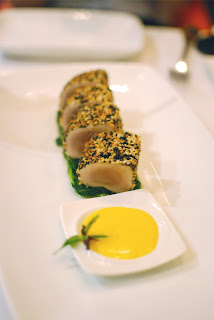 |
| Poles of the kavadi are bolted through stomach flesh. |
As a Foodwalker, the majority of my street roaming
attention is on food, or things related thereto. And within the realm of food
production, selling, cooking and eating – down the countless narrow alleys,
beneath slanted shacks and within the confines of holes in the walls – lies fascinating
culture which both defines the cuisine of the local area and at the same time
transcends it into something greater than the subject of gastronomy, but of humanity.
This element behind indigenous cuisine is one of the main ingredients making food
taste so good.
But every now and then events occur which, though not
related to food, seem still to fit a Foodwalker’s cultural passion. Like this
month’s holy Hindu celebration of Thaipusam.
It is on this one day each year that Tamil worshipers express prayers of gratitude
to Lord Muruga and his victory over evil forces of darkness in the world, and make
the final push for divine help in fulfilling their religious vows. The
celebration is also one of atonement, where worshippers pay penance for the
past year’s failings and pray for a better and more prosperous year ahead.
It’s no easy task. After fasting for anywhere from three
days to a month, a devotee impales himself with religious decorations and items
of significance. I’m not talking pinpricks here – he forces hooks, skewers and
steel spikes into – even through -- his cheeks, tongue, lips, shoulders, chest,
back and beyond. He then embarks, in a trance-like state, on a pilgrimage from
one holy temple to another.
The items attached to hooks and chains vary, each
representing a specific wish. Limes, for example, symbolize protection by the
deities. Small pots contain sacred cow’s milk for cleansing and good fortune. To apply these adornments, selected
areas of skin are massaged for a moment with white, holy ash, then the steel skewers
and hooks are plunged through the tissue and out the other side – with no
pain killers.
Many pious individuals also don steel or wood float-like
structures called a kavadi (appropriately
meaning “burden”) on their shoulders. The kavadi
is traditionally decorated with peacock feathers, aluminum plates and gold
ornaments which show images of Hindu deities. Bells, chains and other elaborate
components drape from them and attach to the skin. Often weighing up to 15 kg
(33 lbs), the kavadi is supported by
long steel spikes which extend down from the base and pierce the skin on the
chest, stomach and back to hold it in place. Support rods are bolted through thick folds of skin at the base of the abdomen to hold it all in place. With every step the sharp points and poles jiggle and
poke a little deeper.
 |
| Spikes in the worshipper's chest help support the kavadi. |
 It requires great determination and endurance to pull off the
pilgrimage and the toll it takes on many worshipers is palpable. Sometime one
will begin to fade out of consciousness, only to be encircled by supporters,
singing and chanting, clanging and drumming – louder and faster – as if to revive
him enough to continue forward. Often someone will pause to hold a pilgrim up
until he regains poise within his spiritual trance. The procession has been
stopped by authorities in many countries, including even in parts of India. But
it remains an annual tradition in Malaysia, where hundreds of thousands head to
the Batu Caves near Kuala Lumpur, and here in Singapore, where it’s an arduous trek
beneath the blistering sun and high humidity from the Sri Srinivasa Perumal
Temple on Serangoon Road to the Sri Thandayuthapani Temple on Tank Road.
It requires great determination and endurance to pull off the
pilgrimage and the toll it takes on many worshipers is palpable. Sometime one
will begin to fade out of consciousness, only to be encircled by supporters,
singing and chanting, clanging and drumming – louder and faster – as if to revive
him enough to continue forward. Often someone will pause to hold a pilgrim up
until he regains poise within his spiritual trance. The procession has been
stopped by authorities in many countries, including even in parts of India. But
it remains an annual tradition in Malaysia, where hundreds of thousands head to
the Batu Caves near Kuala Lumpur, and here in Singapore, where it’s an arduous trek
beneath the blistering sun and high humidity from the Sri Srinivasa Perumal
Temple on Serangoon Road to the Sri Thandayuthapani Temple on Tank Road.
Friends and family walk with the devotee, encouraging him on
and often carrying pots of milk on their heads during the procession. The clamor
of drums, cymbals, horns and bells rings out from every devotee’s group,
helping to keep him entranced, while Indian religious music blasts onto the
street from the many merchants along the pilgrimage path.
 |
| Walking on a bed of nails. |
Though most walk barefooted on the hot pavement of the
streets, some traverse on a literal bed of nails – spiked wooden sandals
strapped to their feet – each step probing deeper into their soles. A cane is
often needed to help support themselves with each, painful step.
Such large-scale public acts of penance are not witnessed
much around the world anymore. And the degree of fortitude and personal
sacrifice of those practicing this sacred passage impales an onlooker’s memory
nearly as deeply as the hooks in the worshipers’ skin. It demands passion and
commitment and generations of prior practice, which draws parallels for this Foodwalker to the
culture behind something else equally as remarkable and magnificent from India: its food.



































